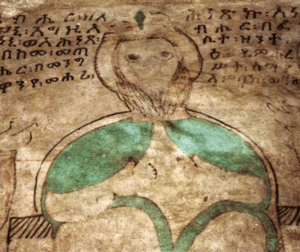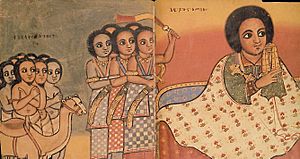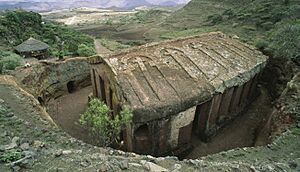Yekuno Amlak facts for kids
Quick facts for kids
|
|||||
|---|---|---|---|---|---|

Contemporary painting of Yekuno Amlak in Genneta Maryam
|
|||||
| Emperor of Ethiopia | |||||
| Reign | 10 August 1270 – 19 June 1285 | ||||
| Successor | Yagbe'u Seyon | ||||
| Born | 1250s Bete Amhara |
||||
| Died | 19 June 1285 Ethiopian Empire |
||||
|
|||||
| Dynasty | House of Solomon | ||||
| Father | Tasfa Iyasus | ||||
| Religion | Ethiopian Orthodox Church | ||||
Yekuno Amlak (also known as Yəkkuno ˀAmlak in Ge’ez) was a very important ruler in Ethiopia. His throne name was Tesfa Iyasus. He was the Emperor of Ethiopia from 1270 to 1285. Yekuno Amlak started the Solomonic dynasty, a royal family that ruled Ethiopia for a very long time, until 1974. He came from a region called Bete Amhara. He became emperor after defeating the last king of the Zagwe dynasty.
How Yekuno Amlak Rose to Power
Yekuno Amlak came from an old family of the Amhara people. Later stories said he was a direct descendant of the ancient kings of Kingdom of Aksum. These kings were believed to be related to the biblical King Solomon. However, there is no real proof that the Aksumite kings were related to Solomon.
Still, these stories were important. They helped Yekuno Amlak claim he was "restoring" the Solomonic dynasty. He overthrew the last of the Zagwe kings in 1270. The Zagwe dynasty had ruled before him. Yekuno Amlak's family said the Zagwe kings were not the true rulers. His descendants continued to tell this story for centuries. It was even written into the Ethiopian constitution in 1955.
Yekuno Amlak was a local leader in the Lake Hayq area. He studied at the Istifanos Monastery there. Some stories say a religious leader named Iyasus Mo'a helped him become powerful. Other stories mention Tekle Haymanot as his teacher and helper.
There was also a legend about a rooster. The story says a rooster crowed for three months, saying whoever ate its head would be king. The king had the rooster cooked, but the cook threw away the head. Yekuno Amlak found and ate the head. This, the legend says, is how he became ruler of Ethiopia.
Traditional history also says that Yekuno Amlak was once imprisoned by the Zagwe King Za-Ilmaknun. But he managed to escape. He gathered many supporters in the Amhara and Shewa regions. He even got help from the Muslim Sultanate of Shewa. With his army, he defeated the Zagwe king in a battle called the Battle of Ansata. Some historians believe the last Zagwe king he defeated was Yetbarak. Others say it was Na'akueto La'ab.
Yekuno Amlak's Time as Emperor
When Yekuno Amlak became emperor, he took his father's name, Tasfa Iyasus, as his throne name. He is said to have fought against the Kingdom of Damot, which was south of the Abbay River. In 1279, a deposed ruler from the Sultanate of Shewa asked Yekuno Amlak for help. Yekuno Amlak helped him get his rule back. Because he had good relationships with the rulers of Harar, he built a new capital city called Ankober near their area.
We know more about his relationships with other countries. For example, he exchanged letters with the Byzantine Emperor Michael VIII. He even sent several giraffes as a gift to the emperor!
At first, he had friendly relations with his Muslim neighbors. However, he wanted a new leader for the Ethiopian Orthodox Church, called an Abuna. This caused some problems. In 1273, he wrote a letter to the Egyptian Mamluk Sultan Baibars. The Sultan was in charge of the Patriarch of Alexandria, who was the head of the Ethiopian church. Yekuno Amlak asked for help getting a new Abuna. This was not his first request. When no Abuna arrived, he thought the Sultan of Yemen had stopped his messenger.
Yekuno Amlak is also known for building the Church of Gennete Maryam near Lalibela. This church has some of the oldest wall paintings in Ethiopia that we can still see today.
Later, his descendant, Emperor Baeda Maryam I, had Yekuno Amlak's body moved and re-buried in the church of Atronsa Maryam.
See also
 In Spanish: Yekuno Amlak para niños
In Spanish: Yekuno Amlak para niños



